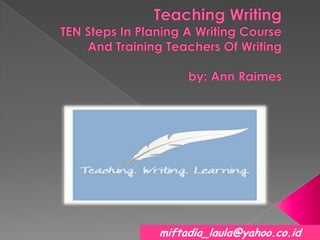
Teaching writing by Ann Raimes
- 2. Writing is the most difficult skill for L2. Not only generating and organizing ideas, but also in translating the ideas into the readable text. Pay attention to skills such as planning, organizing, spelling, punctuati on, word choice, etc.
- 3. a SUBJECT that you know well and understand, a clear PURPOSE for writing, an AUDIENCE that you have identified.
- 4. to ENTERTAIN to INFORM to PERSUADE
- 5. TEN STEPS IN PLANING A WRITING COURSE AND TRAINING TEACHERS OF WRITING
- 6. Goals: - Pass the exam. - Compose writing - Demonstate mastery of form, experiment with language, record experiences and reactions, generate and communicated ideas. - Increase their confidence as writers.
- 7. Constraints: Institutions - Ministries of education - Examining and accreditation agencies - Funding sources The Form of the constraints: - Assigned curricula - Approved textbooks - Designated proficiency examination -
- 8. - - Actions toward the constraints: Form committees, make proposal, run the pilot project. A part of our course address the test or the assigned curriculum. Avoid seeing the ends as means.
- 9. Identify teachers’ ideological position and recognize their perception. What English and what types of writing? What we expect our students to do with what they learn?
- 10. STEP 3. PLANNING CONTENT .
- 11. Is there a correct content of writing classes? Social issues Personal Experiences Cultural Issues Literature Students need topics that allowed them to generate ideas, find the forms to fit ideas and invite risk taking.
- 12. We need to consider which one will be the most important for a course: content, organization, originality, style, flu ency, accuracy, etc. We need to form priorities. Do a need analysis, balancing institutional goals with what students need to learn and what they need to use writing for.
- 13. TYPES OF THE SYLLABUS ORGANIZATION FOR WRITING COURSES. STRUCTURAL - Organized around grammar and sentece patterns. (sentences, descriptions, analyses… etc) FUNCTIONAL - Organized around Rhetorical activities: describing, defining, explaining, arguing, persuading, comparing and contrasting, classifying.
- 14. TOPICAL - Organized around themes: housing, health, house, education or abstractions like succes or courage. SITUATIONAL - Organized around situational transactions: Applying for a jobs, writing letter to the newspaper, writing bussines memo etc.
- 15. SKILLS AND PROCESS - Organized around skills and process as generating ideas, organizing ideas, revising, writing fluency, writing effective, developing arguments. TASKS – Organized around problem activities such as producing a class magazine, comparing the structure of texts written for different audieces and purposes, examining the differences between ESL text book situations and the expectations of the students’ culture.
- 16. Teachers can turn to other materials such as videos, software and books. There are 7 features of selecting materials: topics – types of writing – opportunities for and instruction methods of generating ideas – instructions on principles of rethorical organization – opportunities for collaboration – opportunities for revision and instruction – editing and proof reading.
- 17. The teacher have to be student to think about what students will be doing and lerning in the classroom rather than the comprehensiveness of the information we will imparting. So we need to think also what will we do in the class.
- 18. Not every piece of writing has to be corrected/seen by the teacher. Students can check their friends’ paper. Every body has their own method of responding.
- 19. Use of questionenaires, reflective logs. PORTFOLIOS Include some specified types of writing: in-class writing and revised work. Another teacher could be the evalatuator, and the teacher becomes in a coach.
- 20. We need to think why one class activity works and another does not. If there is a new approach, note its effect. And the best way to read is by writing.
- 21. Choose a topic choose a genre get ideas discuss ideas with others to get new perspectives find grammar and lexis suitable for the text study sample and model texts similar to what they want to write co-write sections of text in groups write a final version, find appropriate readers.
